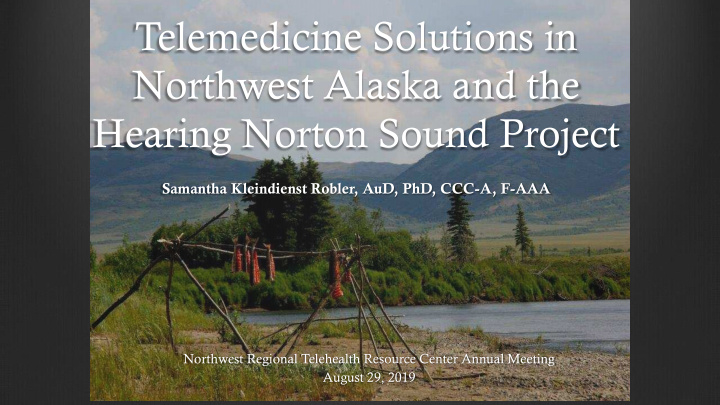



Telemedicine Solutions in Northwest Alaska and the Hearing Norton Sound Project Samantha Kleindienst Robler, AuD, PhD, CCC-A, F-AAA Northwest Regional Telehealth Resource Center Annual Meeting August 29, 2019
Objectives Discuss telemedicine solutions for audiologic/otologic care at Norton Sound Health Corporation Describe a community randomized trial evaluating an mHealth school hearing screening and telemedicine referral process
Disclosures No disclosures Funding: Patient-Centered Outcomes Research Institute (PCORI AD-1602-34571) Clinicaltrials.gov registration: NCT03309553 The views in this presentation are solely the responsibility of the authors and do not necessarily represent the views of PCORI, its Board of Governors, or Methodology Committee
Treatable Hearing Loss Historical Data from Alaska 16-31% prevalence of hearing loss 65-76% >1 episode otitis media General US population 1.7-5% prevalence of hearing loss Reed D et al. Am J Public Health 1967. Kaplan GJ et al. Pediatrics 1973. Niskar AS. JAMA 1998. Curns AT et al. Pediatrics 2002; Singelton RJ et al. Pediatr Infect Dis 2009. Smith DF, Boss EF. Laryngoscope 2010. Singleton RJ et al. Pediatr Infect Dis 2018.
Lifelong Impact Kuguenko Illustration
Alaska Native Tribal Health Consortium
AFHCAN Networked telemedicine solution Alaska Federal Health Care Partnership (AFHCP) VA, DoD, Coast Guard, IHS, ANTHC Connects 248 sites (44 organizations) Dermatology, Dentistry, Cardiology, Otolaryngology, Audiology, Primary Care, Optometry
Workflow CHA Case AuD Coordination Rx ENT
Store-and-Forward Video Teleconference (VTC) In-person Workflow for use of telemedicine in audiology and otolaryngology specialty care to increase access and timeliness of care, while reducing travel
Telehealth Services Diagnostic: video otoscopy, tympanometry, acoustic reflexes, OAEs, surgical/medical management Habilitation/Rehabilitation: hearing aid fitting and programming, troubleshooting, counseling, aural rehabilitation Newborn hearing screening follow-up Not yet tackled: Balance assessment, CI mapping, electrophysiologic testing
The Project What we know: treatable hearing loss in this region is high Ear infections are one of the top 5 diagnoses Hearing loss in children can impact traditional oral culture, school performance, and vocational opportunities What exists: state-mandated hearing screenings Telemedicine What is missing: Referral process for hearing screening that prevents children being lost to follow-up
Key Questions 1. What is the best way to identify children with undiagnosed hearing loss? 2. How do we improve the referral process to ensure timely diagnosis and treatment?
Goals Evaluate a new school-based screening and referral process that utilizes mobile health and telemedicine technology Compare current school screening with new mHealth screening that includes a specific assessment of middle ear function Compare current referral process with new expedited telemedicine referral
Outcomes Sensitivity and Hearing loss specificity of prevalence screening protocols Time to ICD-10 ear/hearing diagnosis Hearing-related School performance quality of life
Community GOAL: Understand the insights, experiences, and perspectives of community members, patients, parents, children, health care providers, teachers, school and hospital administrators, and other key stakeholders as it relates to hearing loss in rural Alaskan communities and the conception/design/dissemination of the study Focus groups and community events (beginning/end) Semi-structured interviews
Overview Cluster randomized trial in 15 communities in northwest Alaska All children eligible (K-12) Target enrollment n = 1500
Timeline
Community Engagement Engage people representing the population of interest and other relevant stakeholders in ways that are appropriate and necessary in a given research context (PCORI Methodology Standards, PC-1)
Community Engagement Identification of the problem and conception of the question Design of the study Implementation Dissemination
Community Communication Outreach Specialist Stakeholders Research and Communication Coordinator Patient Partner Lead Education Investigators Community Events Lead Parent Focus groups and interviews NSHC Lead Audiology Duke University Lead ENT Surgeon John Hopkins Lead Hospital University Administrator Addressing hearing loss disparities in a rural Alaska Native Population
Collaboration
www.hearingnortonsound.org
Susan Emmett- Co-PI Phil Hofstetter- Lead Hospital Administration Stakeholder (Co-PI 2017-2018) Laureli Ivanoff- Communication Outreach Specialist (2017-2018) Clay Jones-Communication and Research Coordinator (2018-present) Paul “Bebucks” Ivanoff - Lead Parent Stakeholder Patty Vink- Lead Education Stakeholder (2017-2018) Jessie Towarak- Lean Education Stakeholder (2018-2019) THE TEAM Stephanie McConnell- Lead Patient Partner John Kokesh-Lead ENT Surgeon Stakeholder Alain Labrique- Co-Investigator Nae-yuh Wang- Statistician and co-investigator Joe Gallo- Co-Investigator Myself- Co-PI and Lead Audiology Stakeholder (Co-PI 2018-current) AUDIOLOGISTS: Geoffrey Waite, Sean Smith, Kristin Follett, Beverly LeMaster
Questions? Contact info : Skleindienst@nshcorp.org 907-434-0433
Recommend
More recommend